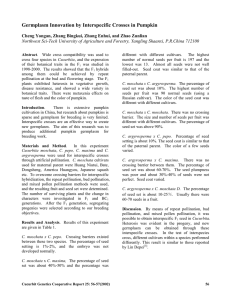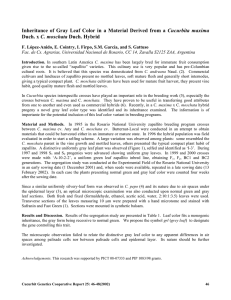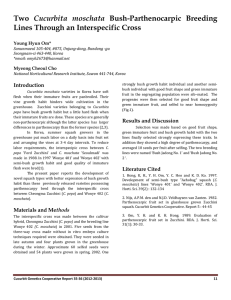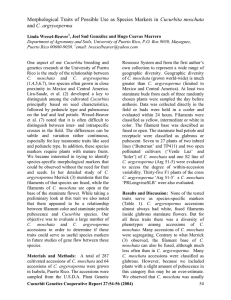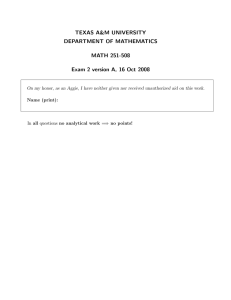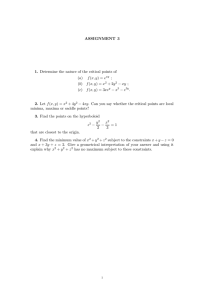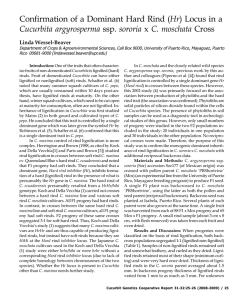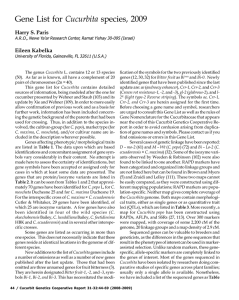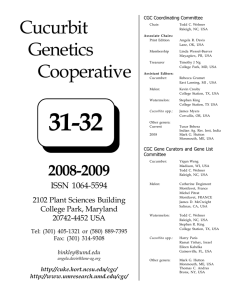Cucurbita maxima Cucurbita moschata Cheng Yongan, Zhang Bingkui, Zhang Enhui, Zhao Zunlian
advertisement
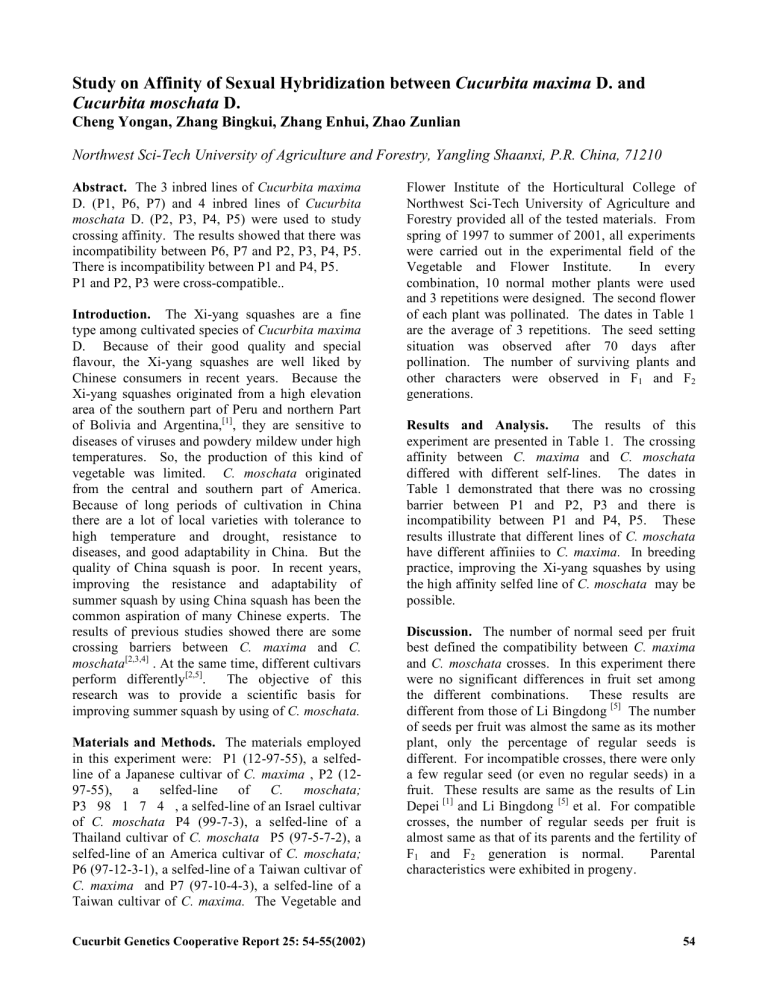
Study on Affinity of Sexual Hybridization between Cucurbita maxima D. and Cucurbita moschata D. Cheng Yongan, Zhang Bingkui, Zhang Enhui, Zhao Zunlian Northwest Sci-Tech University of Agriculture and Forestry, Yangling Shaanxi, P.R. China, 71210 Abstract. The 3 inbred lines of Cucurbita maxima D. (P1, P6, P7) and 4 inbred lines of Cucurbita moschata D. (P2, P3, P4, P5) were used to study crossing affinity. The results showed that there was incompatibility between P6, P7 and P2, P3, P4, P5. There is incompatibility between P1 and P4, P5. P1 and P2, P3 were cross-compatible.. Introduction. The Xi-yang squashes are a fine type among cultivated species of Cucurbita maxima D. Because of their good quality and special flavour, the Xi-yang squashes are well liked by Chinese consumers in recent years. Because the Xi-yang squashes originated from a high elevation area of the southern part of Peru and northern Part of Bolivia and Argentina,[1], they are sensitive to diseases of viruses and powdery mildew under high temperatures. So, the production of this kind of vegetable was limited. C. moschata originated from the central and southern part of America. Because of long periods of cultivation in China there are a lot of local varieties with tolerance to high temperature and drought, resistance to diseases, and good adaptability in China. But the quality of China squash is poor. In recent years, improving the resistance and adaptability of summer squash by using China squash has been the common aspiration of many Chinese experts. The results of previous studies showed there are some crossing barriers between C. maxima and C. moschata[2,3,4] . At the same time, different cultivars perform differently[2,5]. The objective of this research was to provide a scientific basis for improving summer squash by using of C. moschata. Materials and Methods. The materials employed in this experiment were: P1 (12-97-55), a selfedline of a Japanese cultivar of C. maxima , P2 (1297-55), a selfed-line of C. moschata; P3 98 1 7 4 , a selfed-line of an Israel cultivar of C. moschata P4 (99-7-3), a selfed-line of a Thailand cultivar of C. moschata P5 (97-5-7-2), a selfed-line of an America cultivar of C. moschata; P6 (97-12-3-1), a selfed-line of a Taiwan cultivar of C. maxima and P7 (97-10-4-3), a selfed-line of a Taiwan cultivar of C. maxima. The Vegetable and Cucurbit Genetics Cooperative Report 25: 54-55(2002) Flower Institute of the Horticultural College of Northwest Sci-Tech University of Agriculture and Forestry provided all of the tested materials. From spring of 1997 to summer of 2001, all experiments were carried out in the experimental field of the Vegetable and Flower Institute. In every combination, 10 normal mother plants were used and 3 repetitions were designed. The second flower of each plant was pollinated. The dates in Table 1 are the average of 3 repetitions. The seed setting situation was observed after 70 days after pollination. The number of surviving plants and other characters were observed in F1 and F2 generations. Results and Analysis. The results of this experiment are presented in Table 1. The crossing affinity between C. maxima and C. moschata differed with different self-lines. The dates in Table 1 demonstrated that there was no crossing barrier between P1 and P2, P3 and there is incompatibility between P1 and P4, P5. These results illustrate that different lines of C. moschata have different affiniies to C. maxima. In breeding practice, improving the Xi-yang squashes by using the high affinity selfed line of C. moschata may be possible. Discussion. The number of normal seed per fruit best defined the compatibility between C. maxima and C. moschata crosses. In this experiment there were no significant differences in fruit set among the different combinations. These results are different from those of Li Bingdong [5] The number of seeds per fruit was almost the same as its mother plant, only the percentage of regular seeds is different. For incompatible crosses, there were only a few regular seed (or even no regular seeds) in a fruit. These results are same as the results of Lin Depei [1] and Li Bingdong [5] et al. For compatible crosses, the number of regular seeds per fruit is almost same as that of its parents and the fertility of F1 and F2 generation is normal. Parental characteristics were exhibited in progeny. 54 Table 1. Interspecies hybridization between Cucurbita maxima D. and C. moschata D C. maxima×C. moschata × P1 (12-97-55)○ Survive No. of flowers Percentage of No. of regular percentage of crossed fruit(%) seed/fruit F1 plants 30 79 356 a 99.0 a P1 (12-97-55)×P2 (12-97-56) 30 81 347 a 98.0 a P1 (12-97-55)×P3 (98-1-7-4) 30 77 293 a 96.7 a P1 (12-97-55)×P4 (99-7-3) 30 73 4b 25.0 b P1 (12-97-55)×P5 (97-5-7-2) 30 76 2b 0b × P6 (97-12-3-1)○ 30 82 223 a 99 .0a P6 (97-12-3-1)×P2 (12-97-56) 30 79 0b 0b P6 (97-12-3-1)×P3 (98-1-7-4) 30 76 0b 0b P6 (97-12-3-1)×P4 (99-7-3) 30 82 0b 0b P6 (97-12-3-1)×P5 (97-5-7-2) 30 80 0b 0b × P7 (97-12-3-1)○ 30 75 207 a 99.0 a P7 (97-10-4-3)×P2 (12-97-56) 30 70 0b 0b P7 (97-10-4-3)×P3 (98-1-7-4) 30 73 0b 0b P7 (97-10-4-3)×P4 (99-7-3) 30 71 0b 0b P7 (97-10-4-3)×P5 (97-5-7-2) 30 76 0b 0b Note: Pollination in PM 6-8h every day, picking fruit after pollination - 50 days, collecting seed after picking fruit - days [6,7]. Duncan’s test, the same small letter indicated no significance at P=0.05 level. Literature Cited 1. 2. 3. 4. Lin Depei. 2001. Origin and systematic botany of squash plant. Chinese watermelon and muskmelon,2001(1):36-38 Lin Depei. 2000. Inheritance gene and interspecies cross of squash plant. Chinese watermelon and muskmelon, 2000(3):41-44 Cheng Yongan et al. Preliminary Study on innovation of squash germplasm. Acta Agriculturae Boreali-occidentalis sinica, 2001,10(1):100-102 Chinese Vegetable and Flower Institute. 1987. Cultivation of Vegetable Crops in China. Agricultural Press, Beijing . Cucurbit Genetics Cooperative Report 25: 54-55(2002) 5. 6. 7. Squash branch of CSHS. 2001. Paper Collection of symposium. Beijing. Li Bingdong et al. 1996. Biology researches and breeding progress of gourd crops (Cucurbita L.). Chinese Vegetable, 1996(6): 48-50. Zhao Fukuan et al. 2000. The genotype and relationship between fruit ripeness and seed germinating within fruit in Cucurbita moschata. Beijing Horticulture, 2000(3): 1314. 55
